 Leading Blog | Posts by Month |
 Leading Blog | Posts by Month |
06.30.11

LeadershipNow 140: June 2011 Compilation
Posted by Michael McKinney at 03:08 PM
06.29.11

Leading Views: Four Ways to Change We know what to do to make people happy at work says Brian Tracy. The problem is that we either forget to do those things that make people happy, neglect to do them because we are distracted by other things, refuse to do them because we don’t understand their importance, or, worst of all, do things that actually make people unhappy and then justify our behavior with self-righteous excuses and rationalizations. We know what to do to make people happy at work says Brian Tracy. The problem is that we either forget to do those things that make people happy, neglect to do them because we are distracted by other things, refuse to do them because we don’t understand their importance, or, worst of all, do things that actually make people unhappy and then justify our behavior with self-righteous excuses and rationalizations.
To make people feel really happy about themselves, you don’t have to change your entire personality or become a completely different person, you simply have to treat them exactly the way you would like to be treated, over and over again, until it becomes a series of automatic and easy behaviors for you. There are only four ways that you can change anything about yourself, your life, your work, or your relationships with others:
• What would you like me to do more of in the days and weeks ahead? • What would you like me to do less of? • What would you like me to start doing that I am not doing today? • What would you like me to stop doing altogether? Adapted from Full Engagement! Inspire, Motivate, and Bring Out the Best in Your People by Brian Tracy
Posted by Michael McKinney at 05:33 PM
06.28.11

Civility is the Precondition to Democratic Dialogue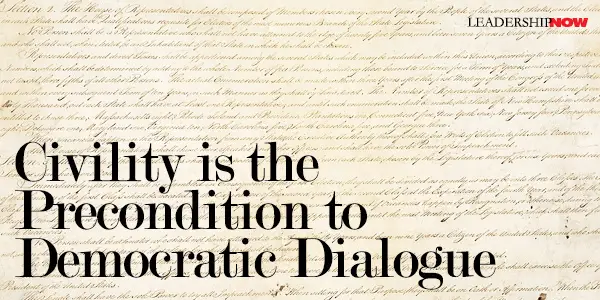
 When you see the lack of civility, characterized by harsh words, yelling, finger-pointing and name-calling, it most often serves to describe the mind of the antagonist than the object of their wrath. We call the world the way we see it—that is, the way we see ourselves. As Anaïs Nin is said to have written, “We don't see things as they are, we see things as we are.” Unfortunately the antagonist will go on to tell story after story of how they have been victimized and will never find peace until they take responsibility for their own mind. Only then will their story change and only then can there be real dialogue. Carter writes: Democracy demands dialogue, and dialogue flows from disagreement. But we can, and maybe must, be relentlessly partisan without being actively uncivil. Indeed, the more passionate our certainty that we are right, the more urgent our need to practice the art of civility—otherwise, we make dialogue impossible, and the possibility of dialogue is the reason democracy values disagreement in the first place. 
Posted by Michael McKinney at 01:58 PM
06.27.11

The Big Vision is Important but People Live in the DetailsMost leaders don’t want to be called a tyrant, a control freak, or even a micromanager. To avoid that, it’s easy to jump into the other ditch and be laissez-faire. Leaders have a duty to navigate between these two extremes as the situation dictates.Typically, we like to present the vision—the values—and leave the details to be sorted out. We like to give the big overarching principle without explaining exactly how it plays out in everyday life. The problem is that everything happens in the details. That’s where people live. That’s where decisions are made, community is built, and your vision and values are realized—or not. We like to articulate the “promised land” and expect that everyone will catch on. That might work for the most highly visible leaders—those interacting with employees day-in and day-out—because they see you translating those values and goals on a day-to-day basis. But seriously, how many of us are that visible? We’re far too busy!?! We don’t want to be caught telling people what to do, but we want everyone on the same page. Life doesn’t work like that. People see the same thing and hear the same thing differently. They interpret it differently and thus it plays out in their behavior differently. And that is where the friction starts. That’s where the community breaks down. That’s where the judgment begins. Organizations, groups and families need more guidance than that. I’m not suggesting that we become control freaks, create even more rules, or become condescending or judgmental, but we need to clarify the vision and values in the details where people live. What do our values look like in everyday life? We need to use examples as they come up to relate everyday behavior to our values. Show where they match-up and where they don’t in a way that leaves room for them to develop good judgment and practical wisdom. From the beginning—and along the way as needed—we need to spell out, “This is the kind of company we want to be, this is the kind of people we want to be, so that means we don’t do this but we do do that.” Specifically. And we then communicate this over and over again in our rhetoric and actions. People need to know and understand your values if their behavior is to be guided by them. If there is a disconnect between your values and everyone’s clear understanding of them, confusion and misbehavior will define your leadership.
Posted by Michael McKinney at 08:17 AM
06.24.11

Does Your Wellbeing Need a Boost?
GALLUP scientists have determined that there are five universal and interdependent elements of wellbeing that differentiate a thriving life from one spent suffering:
Statistically, while 66% are doing well in at least one area, only 7% are thriving in all five. If we are struggling in any one of these areas, as most of us are, it damages our wellbeing and wears on our daily life. Ways to measure and improve in each of these areas is provided in Wellbeing by Tom Rath and Jim Harter. (The Wellbeing Finder can be taken online by using the code provided in the book.) Our wellbeing will not improve if we don’t make a conscious decision to do so. Small changes can have a huge impact. To get started they recommend setting positive defaults. One of the best ways to create more good days is by setting positive defaults. Any time you help your-short-term self work with your long-term self, you have an opportunity. 
Posted by Michael McKinney at 06:12 PM
06.23.11

The Essential Ingredient for Executing Your VisionIf you don’t build a framework of values around your vision, it will fall short of the goal. And those values must be clearly understood by everyone on the team if the initiative is to succeed, for a couple of basic reasons.A vision is what could be, but it is grounded and guided by—or even sent off-course by—your most deeply held values—what is. A vision is generated from and is sustained by values. A vision is generated by values because what we see comes from what we are. The values we hold to, how we interpret where our values have taken us to this point, and the values we discard, inform our vision. Our values give us a line of sight into our future. To have a vision bigger than we are, we need to incorporate values into our thinking that are bigger than we are; values that come from outside ourselves. Values then become the instruction book. They show the way, directing our decisions and behavior. Inasmuch as our vision arises from our values, so too our values support and sustain the vision. The connection between value and vision points to the need to have a firm grasp of our values before we create our vision, because they’ll either point us in a positive direction or send us to a destination full of regret.
Posted by Michael McKinney at 08:45 PM
06.22.11

Leading Views: Keep Dissenters Close to Provide Perspective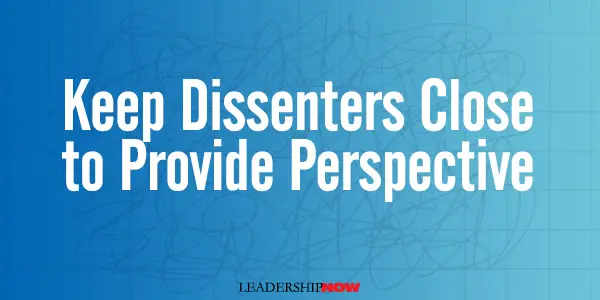

Posted by Michael McKinney at 10:58 PM
06.21.11

Fixing the Game: What Capitalism Can Learn from the NFL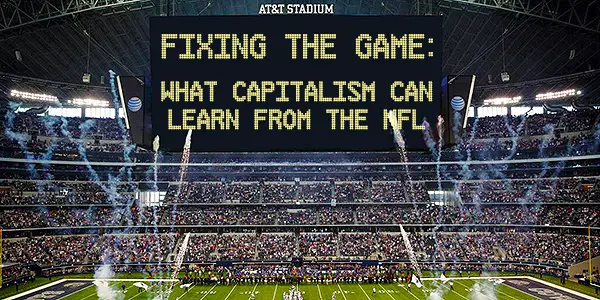
DEAN of the Rotman School of Management, Roger Martin, states in Fixing the Game, "We haven’t looked deeper into blameworthy CEO behavior to understand what really caused it. We haven’t examined the broader theories that underpin our economy and that informed all of those ineffective fixes after the last crash. Instead, we’ve looked for a new scapegoat, chosen to operate from the same fundamental theories, and doubled down on the same fixes." THE STORY BEGINS In 1976, Harvard finance professor Michael Jensen and Dean William Meekling of the Simon School of Business at the University of Rochester published a paper entitled Theory of the Firm: Managerial Behavior, Agency Costs and Ownership Structure [PDF]. They had no way of knowing that it would form the prevailing theory regarding the role of the firm and proper compensation in our society today. The paper argued that the “way to spur executives to best perform their duties in the real market [the world in which factories are built, products are designed and produced and sold, expenses are paid and real dollars of profit show up on the bottom line] was to make their pay significantly dependent on the performance of the company in the expectations market [the world in which shares in companies are traded between investors].” To do this, executives should be compensated with stock and in effect, make them both shareholders and executives. In 1970, in stark contrast to today, stock-based incentives accounted for less than 1 percent of CEO remuneration. That theory, says Roger Martin, “had the unfortunate effect of tightly tying together two markets: the real market and the expectations market.” In Fixing the Game, Martin notes that something similar happened in the NFL. In the NFL there is the real market when teams take to the field to play a game. Real touchdowns and real field goals are scored. And there is the expectations market: gambling. “Gamblers try to guess who will win a given game on a given Sunday and place bets based on that expectation.” The bets are balanced on either side through the use of a point spread which is similar to the stock price in business. WHAT THE NFL DID “But unlike American capitalism, the NFL looked thoughtfully at the relationship between the real game and the expectations game and identified a serious danger….They clearly saw that the pressures of the expectations game could do serious damage to the real game…it could destroy the sport….[they] have enforced a strict separation between the real market and the expectations market…exactly the opposite of the way we have managed it in business.” Martin thinks we could take a lesson from the NFL. We need to quit asking executives to do what they cannot do: beat the expectations forever. “Expectations will get ahead of anything you can actually accomplish” and thus encouraging executives to engage in “point shaving” or “tanking” to cover the spread. “Since 1976, the incidence of large-scale accounting fraud by public companies has increased dramatically. Why? Because executives have millions of reasons to do whatever they can to increase expectations of future earnings.”  American capitalism has embraced a persuasive but ultimately flawed theory to construct their understanding of the economy, the model of executive compensation and the role of business. Our single-minded focus on the expectations market is driving us from crisis to crisis with ever-increasing volatility. Martin skillfully defines the problem and points out why and how we might begin to fix it. 
Posted by Michael McKinney at 08:55 AM
06.20.11

You Can Be Legal and Still Be Wrong
IT’S NOT UNCOMMON to find a big difference between what’s legal and what’s right. Our preoccupation with “what’s legal” ensures more legal problems. If we paid more attention to what’s right, we would take our relationships to a new level. And it’s all about relationships. Legal is about what I can get away with. Ethics is about what is right. Legal requires less thought than ethics. It's easy to shrug off responsibility when I can simply point to a law, a policy, or a rule. “I’m sorry. What can I do?” Legal is about me. Ethics is about you. Ethics requires that you take responsibility for outcomes. Ethics says, “I care what happens to you.” A legal approach simply responds with, “Read the contract. It’s all there.” Too many organizations base their actions on the answer to the question, “Is it legal?” or “Are we protected?” As a result, they often end up on the defensive and consequently and unnecessarily spend excessive amounts of money on public relations, branding, and customer service. If they changed the question to “Is this right?” or “Is this how we would want to be treated?” they would find they have to rely less on what is legal and as a result create better relations with all stakeholders. But it’s not faceless organizations that are to blame. It’s individuals in a culture that is preoccupied with “what can I get?” Organizational cultures that ask employees to make everyday decisions based on expediency, one-sided considerations, and policies and procedures designed to protect rather than facilitate, are going to miss the mark. Regardless of contracts, policies, and procedures, people want to feel like they are being treated fairly. “Is-it-legal?” thinking just isn’t going to get you there. An ethical culture is one that thinks differently. It asks, “What is the right thing to do in this situation?” Ultimately, it is an organizational and individual leadership problem. Anyone in an organization can stop and ask themselves, “Is this right? Is it fair? Is it just?” and respond accordingly. Legal departments should become ethics departments that place the emphasis on doing what is right; advise based on higher values; leaders that place more emphasis on the upside rather than on the downside of an action or decision. How-does-this-help rather than what-is-the-worst-that-can-happen-to-us if we just do what we want? Might doesn’t make right. It makes animosity, distrust, and isolation. Of course, we need some laws, rules, and procedures, but they must be applied ethically. We will always be confronted with legal challenges, but if our responsible response is focused on what is right and not on what we can get away with, we will become better companies and employees. 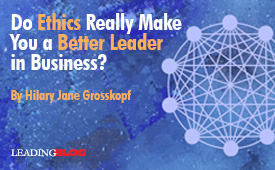 
Posted by Michael McKinney at 10:13 AM
06.17.11

42 Rules for Your New Leadership RoleWhether you have just been given a new leadership role, are currently in a leadership role, or have consciously decided to begin to lead from where you are, Pam Fox Rollin has created a concise guide for doing it successfully. 42 Rules for Your New Leadership Role gives you a starting point to work from to help prevent costly errors from occurring and will also aid in improving one's overall leadership experience.In all the busyness that surrounds a new role, it’s easy to forget the essential little things that make all the difference. We easily get caught up in the activity and don’t slow down enough to think about what it is we really need to be doing. New roles bring with it new expectations and that means doing things differently than we have done them before. 42 Rules will help you to gather your thoughts and lead thoughtfully. A quick daily review will help to keep you focused on the agenda that really matters. The book is divided into seven sections: Set Yourself up for Success: Take charge of your start. New roles require new starts. “When brains are overloaded, people tend to rely on what they’ve done before, even when that didn’t work very well or is out of place in the new context. Ironically, this tunnel vision and rigidity is especially true of leaders who have experienced success.” Map the Terrain: Investigate what matters. “If you’re going to deliver for someone, make it your priority to deliver up. That gives you breathing room to deliver for everyone else.” Common mistakes: Seeing smoke and running off to chase fires; Adopting other people’s agendas with insufficient data and thought; Becoming buried under the pent-up piles of tasks. Show up Wisely: Know yourself. Use your strengths, but avoid diagnosing problems to suit your strengths—dragging the problem into your comfort zone. “If you're good at running numbers, be aware that you may frame problems quantitatively, when lack of strategic insight is at the root of the problem. Seeing problems as they really are—rather than as you are—is especially essential in your first months on the job.” Start your Wins: You will feel the pressure to start with something dramatic. Pick smart quick wins. “The quick wins you choose will signal to others what matters to you….Bold moves in the second and third quarters of your tenure tend to accelerate your career.” Create your Management System: Define your own processes. At the same time, “lighten up on talking about ‘your leadership style’ and think more about what you could do that would be truly useful for your team members and colleagues.” Spotlight your team and grow more leaders. Stay Smart: Keep learning. “If you neglect to stay smart, seek feedback, and build your network, no one is likely to mention the gap. You’ll just become less valuable.” Set You and Your Team to Thrive: “Many people can drive themselves and their teams to exceed expectations for a quarter or two. The real challenge is to build a team—and a life—that sustains high performance.” “Extend a hand to the next round of leaders by sharing what you’ve learned.” What rules have helped you in your leadership role? 
Posted by Michael McKinney at 06:36 PM
06.16.11

To Focus on the Work, You Must Focus on People Doing the Work
Many managers think they manage the work. They don’t. They’re responsible for the work, but they get work done by influencing the people who do the work. What makes this complicated is what Peter Drucker pointed out: when you hire a hand, it comes with a head and heart attached. So you must pay attention, lots of attention, to the whole person—head and heart—because you need more than your people’s time and attention. Most work now requires knowledge, judgment, thinking, and decision making, and so it matters if people care about what they do. You cannot simply give them orders and criticism. That rarely produces the kind of engagement you need. Other, less direct but more effective forms of influence—such as support, development, and encouragement—are needed that engage the whole person. Do you tend to focus on the work or on the people doing the work? In other words, do you tend to confront and criticize, or do you support people and give them what they need to do good work? Adapted from Being the Boss: The 3 Imperatives for Becoming a Great Leader by Linda A. Hill and Kent L. Lineback. 
Posted by Michael McKinney at 05:45 PM
06.14.11

5 Leadership Lessons: Tim Elmore’s Generation iY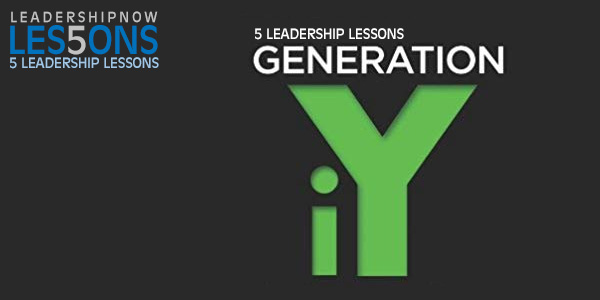
GENERATION iY are the younger Millennials born after 1990. Their world has been defined by technology and shaped by the Internet— iPod, iBook, iPhone, iChat, iMovie, iPad, and iTunes—and for many of them, life is pretty much about "I," says Tim Elmore in Generation iY. “Generation Y is the largest generation in American history and the second half of this generation is different than the first half, measurably different.” “[H]ere’s something that really saddens me: These kids really do desire to change the world; they just don’t have what it takes to accomplish their lofty dreams,” Elmore writes. “When the work becomes difficult, they change their minds and move on to something else. The new term for them is ‘slactivists’ – they are both slackers and activists.” Elmore argues that we need to change the way we interact with them so that they can grow into adulthood and be the leaders they need to be. Generation iY is an eye-opening book. It’s backed with research and filled with practical advice. This is an important book for parents and other adults that lead them. Elmore’s thought-provoking analysis will help you to not only rethink your approach in dealing with others but rethink the assumptions that shape your own worldview.
Invest TIME with the next generation. “We must instill in Generation iY,” says Elmore, that “leadership is leveraging my influence for a worthwhile cause.” 
Posted by Michael McKinney at 10:44 PM
06.13.11

7 Guiding Principles for Developing Leadership TalentPeople deliver numbers. If you want the numbers, you need the people. As a leader you need to know how to judge raw human talent. In The Talent Masters, Bill Conaty and Ram Charan explain how to do it.To develop talent, you need to become intimate with your people; to know the essence of each individual. Talent masters can identify a person’s talent more precisely than most people simply because they excel at observing and listening. And they institutionalize this skill to create their own supply of good judges. It simply must become part of the culture. Talent development is not an event. It is a process. To make it sustainable it must become part of the culture. And no one needs to understand that more than the CEO. When you have an organization devoted to a person, you have a cult. When you have an organization devoted to a set of principles and values, you have a culture. Developing people simply must be a priority from the top down. That leads us to Conaty and Charan’s first principle of the talent masters:

Posted by Michael McKinney at 10:10 PM
06.07.11

Transforming an Ordinary Moment into a TouchPoint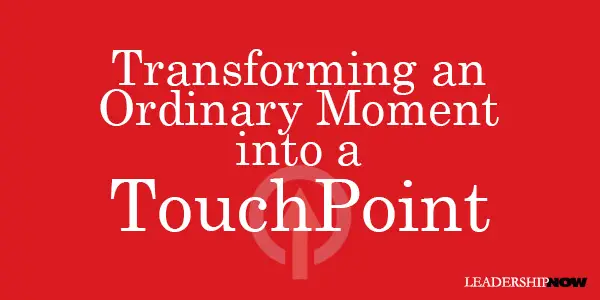
WE ALL have those moments when we are too busy for the people around us. But those moments are the work of leaders. Those are the moments when we can help to move things from what they are to what they could be. Campbell CEO Doug Conant said, “To me, they’re not interruptions. They’re opportunities to touch someone and improve the situation.” TouchPoints, by Doug Conant and Mette Norgaard, describes a new way of thinking about the work of leadership. TouchPoints are those moments in the day when you have the opportunity to touch the lives of other people. Each has the potential to become a high point or a low point in someone’s day. “Each is an opportunity to establish high performance expectations, to infuse the agenda with greater clarity and more energy, and to influence the course of events.”Every TouchPoint is spring-loaded with possibilities. Each one can build—or break—a relationship. Even a brief interaction can change the way people think about themselves, their leaders, and their future. TouchPoints exposes the extreme responsibility that leadership is. A responsibility that in our overloaded age, we often overlook. To make the most of your TouchPoints, they have created the TouchPoint Triad: listen, frame, advance. In any moment you begin by asking, “How can I help?” Then you listen intently. This prepares you and helps you find out what is really going on. Be curious and keep listening for the real issue. Next, you frame the issue to be sure that everyone in the TouchPoint is on the same page. Third, you advance the agenda. People come to you because they want results. Once you know what is needed, do what you can in that moment to advance the agenda; decide on what the next step is, and who is responsible to do it. After the TouchPoint is over, make a point to check-in and see how well the action plan is going by asking something like, “How did it go?” or “Is there anything else you need from me?” It’s a reminder that you care and lets you know if you were genuinely helpful.
A TouchPoint is about really connecting with others and improving results. It’s about engaging in a way that is alert, abundant, authentic, and adaptable: You need to be alert to the real issues. “When you are fully present, you can see the gaps in someone’s line of logic and pick up bits of information that provide clues to what is going on.” You need to be abundant in your thinking; rejecting the either/or scarcity mindset. To be authentic is to embrace the work of the leader and “live by a very clear code that provides an underlying clarity and consistency in every TouchPoint.” “The secret to being adaptable is to develop a broad range of skills, so that you can adjust and adapt in the moment.” Throughout TouchPoints, you will find many nuggets of relationship wisdom to help you, as they put it, “work with, not against, the nature of things.” The authors insist that you clarify your own leadership model so that you can apply it consistently. To that end, they suggest that you answer two vital questions: What makes people give the very best of themselves? What makes for ever-stronger performance in an ever-changing world? Your answers will help you to define how you see yourself, other people, and the world around you. 
Posted by Michael McKinney at 11:06 PM
06.03.11

4 Lessons from the Toyota Crisis
“Crisis response must start by building a strong culture long before the crisis hits,” say Jeffrey Liker and Tim Ogden, authors of Toyota Under Fire. Turning crisis into opportunity is all about culture. It’s not about PR strategies, or charismatic leadership, or vision, or any specific action by any individual. It’s not about policies or procedures or risk mitigation processes. It’s about the actions that have been programmed into the individuals and teams that make up a company before the crisis starts. The accident in August 2009 that took the lives of four people in a runaway Lexus brought national attention to Toyota. Fueled by innuendo and speculation by Congress and some media, it escalated into something it was not. Toyota Under Fire deals with not only the massive recall of 2009-2010, but also Toyota’s response to the oil crisis and recession. Toyota’s response has not been typical, but it does follow the Toyota Way. It is a reflection of their culture. That way includes what is probably Toyota’s “greatest contribution to the world as a model of real continuous improvement” at and by all levels in the organization. Liker and Ogden describe the Toyota Way as: Face challenges with a clear head and positive energy. Hold fast to your core values and your vision for the company. Always start with the customer. Understand the problems that you face by analyzing the facts, including your own failings, and understanding the root causes. Thoroughly consider alternative solutions, then pick a path, develop a detailed plan, and execute with discipline and energy. “You do not turn a culture off and on again like a light switch.” Culture—like character—is built over decades of living your values in the real world. And then in a crisis, when you really need it, it is there to carry you through. The authors isolated four lessons for dealing with a crisis: Lesson 1: Your Crisis Response Started Yesterday. What a company does isn’t likely to change much when a crisis strikes or for any length of time. “They are driven by culture, and culture simply can’t be changed quickly, even in a crisis…. Therefore, the chief questions to ask yourself about how your company will respond in a crisis are not contingency plans and policies, but about your culture and your people. Have you created a culture that rewards transparency and accepts responsibility for mistakes? Have you created a culture that encourages people to take on challenges and strive for improvement? Have you created a culture that values people and invests in their capabilities? Have you created a culture that prioritizes the long term?”Lesson 2: A Culture of Responsibility Will Always Beat a Culture of Finger-Pointing. Common sense? Yes, but the question is how far do you go in accepting responsibility? What if the factors were beyond your control? The answer illuminates an important nuance in understanding Toyota’s culture of responsibility and problem-solving. “There is no value to the Five Whys [the belief that you have to ask why at least five times] if you stop when you find a problem that is outside of your control. There will always be factors outside of your control. When you reach a cause that is outside of your control, the next why is to ask why you didn’t take into account forces outside of your control—either by finding an alternative approach or by building in flexibility to adjust to those forces.” Lesson 3: Even the Best Culture Develops Weaknesses. The greatest threat to a culture of continuous improvement is success. “To survive the weaknesses that inevitably develop, a corporate culture has to have clear and objective standards, codified in such a way that self-correction is possible. Having a culture that recognizes a loss of direction is absolutely critical to long-term survival.” Lesson 4: Globalizing Culture Means a Constant Balancing Act. The clarity of Toyota’s culture and values is essential to growing the culture in every employee. And there is a balance to strike—the balance between centralized and decentralized, local and global—that is not easy. “There is an inherent demand here that especially the people who are at the margins, at the periphery of the organization, be deeply steeped in the culture, and that they are to be trusted to make decisions because they are at the gemba.” One of the root causes of the crisis they identified was centralized decision making. They will now pursue a regionalization strategy which will require trusting the leaders they have trained to maintain the culture. Toyota Under Fire is an in-depth look at the value of having a strong culture that can serve you when things go south. The discussions explaining the reasoning behind why Toyota does what it does were very helpful. They demonstrate that the most important decisions are the ones made before the crisis. And then when the crisis hits, return to basics. Go deeper and wider. 
Posted by Michael McKinney at 05:21 PM
06.01.11

First Look: Leadership Books for June 2011Here's a look at some of the best leadership books to be released in June.




For bulk orders call 1-800-423-8273  Build your leadership library with these specials on over 120 titles. All titles are at least 40% off the list price and are available only in limited quantities. “We read to know we are not alone.” —C.S. Lewis
Posted by Michael McKinney at 08:16 AM
|
BUILD YOUR KNOWLEDGE


How to Do Your Start-Up Right STRAIGHT TALK FOR START-UPS 
Grow Your Leadership Skills NEW AND UPCOMING LEADERSHIP BOOKS 
Leadership Minute BITE-SIZE CONCEPTS YOU CAN CHEW ON 
Classic Leadership Books BOOKS TO READ BEFORE YOU LEAD |
|